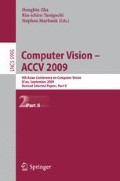Abstract
The factorization 3-D reconstruction method requires that all feature points must occur in all images in a sequence. A long sequence has to be divided into multiple subsequences for partial reconstructions. This paper proposes an algorithm for dividing a long sequence for factorization-based Structure and Motion (SaM). First, we propose an Algorithm for Detecting a few Critical Configurations (ADCC) where Euclidean reconstruction degenerates. The critical configurations include: (1) coplanar 3-D points, (2) pure rotation, (3) rotation around two camera centers, and (4) presence of excessive noise and outliers in the measurements. The configurations in cases of (1), (2) and (4) will affect the rank of the scaled measurement matrix (SMM). The number of camera centers in case of (3) will affect the number of independent rows of the SMM. By examining the rank and the row space of the SMM, we detect the above-mentioned critical configurations. With the proposed ADCC algorithm, we are able to divide a long sequence into subsequences such that a successful 3-D reconstruction can be obtained on each subsequence with a high confidence. Experimental results on both synthetic and real sequences demonstrate the effectiveness of the proposed algorithm for an automatic 3-D reconstruction using the factorization method.
Access this chapter
Tax calculation will be finalised at checkout
Purchases are for personal use only
Preview
Unable to display preview. Download preview PDF.
References
Han, M., Kanade, T.: A perspective factorization method for euclidean reconstruction with uncalibrated cameras. J. Visual. Comput. Animat. (2002)
Sturm, P.F.: Critical motion sequences for the self-calibration of cameras and stereo systems with variable focal length. Image and Vision Computing 20(5-6), 415–426 (2002)
Kahl, F.: Critical motions and ambiguous eucldian reconstructions in auto-calibration. In: Proc. Int. Conf. Computer Vision, vol. 1, pp. 469–475 (1999)
Torr, P., Zisserman, A., Maybank, S.: Robust detection of degenerate configurations whilst estimating the fundamental matrix. Int. J. Computer Vision 71(3), 312–333 (1998)
Jung, Y.Y., Hwang, Y.H., Hong, H.K.: Frame grouping measure for factorization-based projective reconstruction. In: Proc. ICPR, vol. 4, pp. 112–115 (2004)
Chen, Q., Medioni, G.: Efficient iterative solution to m-view projective reconstruction problem. In: Proc. IEEE Conf. Computer Vision and Pattern Recognition, vol. 2, pp. 55–61 (1999)
Hartley, R.I., Zisserman, A.: Multiple View Geometry in Computer Vision, 2nd edn. Cambridge University Press, Cambridge (2004)
Oliensis, J., Member, S.: Iterative extensions of the sturm/triggs algorithm: Convergence and nonconvergence. IEEE TPAMI 29(12), 2217–2233 (2007)
Mahamud, S., Hebert, M.: Iterative projective reconstruction from multiple views. In: Proc. IEEE Conf. Computer Vision and Pattern Recognition, vol. II, pp. 430–437 (2000)
Heyden, A., Berthilsson, R., Sparr, G.: An iterative factorization method for projective structure and motion from image sequences. Image and Vision Computing 17, 981–991 (1999)
Kanatani, K.: Uncertainty modeling and model selection for geometric inference. IEEE Trans. Pattern Analysis and Machine Intelligence 26(10), 1307–1319 (2004)
Torr, P.: An assessment of information criteria for motion model selection. In: Proc. IEEE Conf. Computer Vision and Pattern Recognition, pp. 47–52 (1997)
castle sequence, http://www.cs.unc.edu/~marc
Author information
Authors and Affiliations
Editor information
Editors and Affiliations
Rights and permissions
Copyright information
© 2010 Springer-Verlag Berlin Heidelberg
About this paper
Cite this paper
Li, P., Gunnewiek, R.K., de With, P. (2010). Detecting Critical Configurations for Dividing Long Image Sequences for Factorization-Based 3-D Scene Reconstruction. In: Zha, H., Taniguchi, Ri., Maybank, S. (eds) Computer Vision – ACCV 2009. ACCV 2009. Lecture Notes in Computer Science, vol 5995. Springer, Berlin, Heidelberg. https://doi.org/10.1007/978-3-642-12304-7_36
Download citation
DOI: https://doi.org/10.1007/978-3-642-12304-7_36
Publisher Name: Springer, Berlin, Heidelberg
Print ISBN: 978-3-642-12303-0
Online ISBN: 978-3-642-12304-7
eBook Packages: Computer ScienceComputer Science (R0)

